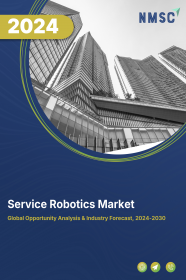
Service Robotics Market by Component (Hardware, Software, and Support Services), by Type (Domestic Service Robots, and Professional Service Robots), by Mobility Platform (Ground (Wheeled/Legged), Aerial Systems, and Others), by Autonomy Level (Teleoperated Robots, Semi-Autonomous, and Fully Autonomous) , by End-User (Consumers (Households), Commercial, and Public Sector)- Global Opportunity Analysis and Industry Forecast, 2024 – 2030.
Market Definition
The Service Robotics Market was valued at USD 43.35 billion in 2023 and is predicted to reach USD 173.39 billion by 2030, registering a CAGR of 21.40% from 2024 to 2030.
Service robots streamline and perform a variety of assistive tasks that are menial, time-consuming, distant, dangerous, or repetitive, to assist human beings. These robots are autonomous and operated by a built-in control system with manual override options wherein the control is taken from an automated system and given to the user. Service robots help to manage time and enhance productivity by reducing the workload of the staff and labors across various industries including healthcare, construction, and others. They deliver precise and high-quality services that have improved their usability & dependability. These robots assist humans in various applications such as surgeries, construction, automation, domestic help, and others.
Market Dynamics and Trends
The rising demand for service robotics is attributable to the high adoption of the Internet of Robotic Things (IoRT) to access the robots remotely and optimize maintenance. Likewise, the ever-increasing technological advancements including artificial intelligence, automation, and others are likely to augment the market growth. Also, the scarcity of trained workers has influenced various industries including medical & healthcare and inspection & maintenance among others to adopt service robots. These factors are expected to drive market sales.
Moreover, the incorporation of robots for companionship, handicap help, and aid for the growing geriatric population, including Lovot, Miko, EMO, Misa, and others is further expected to boost the service robotics market growth. The high initial investment required for the integration, procurement, and programming along with the high maintenance cost of service robots are factors expected to restrain the growth of the market during the forecast period.
For instance, in 2021, according to the estimates of the Robotic Industries Association (RIA), the maintenance cost of service robots is approximately 500 million USD per annum. On the contrary, the growing adoption of swarm intelligence technology that enables the robots to perform various complex tasks including explosive disarmament, fire-fighting, minimally invasives surgeries, and drilling in construction sites with ease are expected to create lucrative growth opportunities for the market players in future.
Market Segmentation and Scope of Study
The global service robotics market is segmented based on type, operating environment, component, application, and geography. Based on type, the market is classified into personal robots and professional robots. Based on operating environment, the market is segmented into aerial, marine, and ground. On the basis of component, the market is categorized into hardware and software. Based on application, the market is divided into field, logistics, domestic, defense, healthcare, inspection and maintenance, construction, entertainment, education, and others. Geographical breakdown and analysis of each of the aforesaid classification include regions comprising North America, Europe, Asia-Pacific, and RoW.
Geographical Analysis
Asia-Pacific dominated the global service robotics market in 2021 and is potently expected to remain dominant in the market throughout the forecast period. This is attributed to factors such as the presence of leading manufacturing countries that include Japan, China, and South Korea. For instance, according to the data published by the International Federation of Robotics (IFR), Japan is the world’s largest industrial robot manufacturer delivering 45% of the global supply, as of March 2022. Their export ratio rose to 78% when 136,069 industrial robots were shipped.
Also, the rapid increase in the adoption of service robots in China, Japan, and India in various applications such as healthcare and construction is driving the market in this region. For instance, in March 2020, a Japanese start-up UBTECH Robotics developed medical robots that can be utilized to conduct disinfection in hospitals as well as check people’s temperature at a Chinese hospital in Shenzhen. These robots replaced workers and have evolved to be even smarter with the help of artificial intelligence.
North America is projected to exhibit substantial growth in the global service robotics market during the forecast period, due to the growing adoption of contactless deliveries in the U.S. as well as a suitable investment scenario for the research on assistive technologies. For instance, in March 2020, a U.S. start-up Starship Technologies developed service robots that have been initially used for delivering pizzas and later to deliver stocks from food stores in the neighborhood.
Also, factors such as the accessibility of scientifically advanced service robots in the healthcare sector, especially to assist in operations and monitoring patients are expected to boost the market. For instance, in June 2020, Intuitive announced the FDA clearance of a mobile cone-beam CT (CBCT) imaging technology integration and the Ion Endoluminal System used for robotic-assisted bronchoscopy.
Competitive Landscape
The service robotics market includes several market players, such as Intuitive Surgical, Inc., Ecovacs Robotics Co., Ltd., IRobot Corporation, Boston Dynamics, Inc., UBTECH Robotics Corp., Omron Corporation, SoftBank Robotics Group Corp., Locus Robotics Corp., Mobile Industrial Robots (MiR) A/S, Starship Technologies Ltd., Fetch Robotics, Inc., Blue Ocean Robotics A/S, PAL Robotics S.L., Anybotics AG, Clearpath Robotics Inc., Geek+ Technology Co., Ltd., Vecna Robotics Corp., Diligent Robotics, Inc., Aethon, Inc., Agility Robotics, Inc., and among others. These market players are adopting various joint venture strategies across various regions to maintain their dominance in the global service robotics market.
For Instance, in January 2025, Ecovacs Robotics Co., Ltd. aLaunched DEEBOT X8 PRO OMNI: with 18,000 Pa suction, smart mapping, and upgraded mopping system, Introduced DEEBOT T50 PRO OMNI: ultra-thin, smart vacuum with TÜV-certified hygiene features and Released WINBOT MINI: a compact window-cleaning robot with ultrasonic spray and blackout detection. Moreover, in July 10, 2025, Intuitive Surgical, Inc.FDA cleared a new curved vessel sealer designed for use with the da Vinci system.
Key Segments Markets
By Component
-
Hardware
-
Robotic Arms & Manipulators
-
Sensors & Vision Systems
-
Control Units
-
Actuators & Drive Systems
-
Power Systems
-
Chassis & Mobility Platforms
-
-
Software
-
Operating Systems & Middleware
-
Navigation & SLAM
-
Human-Robot Interaction (HRI) Interfaces
-
Fleet/Swarm Management Platforms
-
AI & ML Algorithms
-
-
Support Services
-
Maintenance & Repair
-
Training & Consulting
-
System Integration
-
By Type
-
Domestic Service Robots
-
Home Maintenance
-
Floor Cleaning (Vacuum, Mop)
-
Outdoor Care (Lawn, Pool, Window)
-
-
Personal Assistance
-
Companionship & Social Interaction
-
Elderly & Disability Support
-
-
Education & Leisure
-
STEM Learning Kits
-
Entertainment & Hobby
-
-
-
Professional Service Robots
-
Healthcare
-
Surgical Assistance Robots
-
Rehabilitation & Therapy Robots
-
Diagnostic & Lab-automation Robots
-
Hospital Logistics
-
-
Logistics & Supply Chain
-
Warehouse Automation (AGVs, AMRs)
-
Last-Mile Delivery (Indoor & Outdoor)
-
Port & Terminal Operations
-
-
Field Operations
-
Agriculture (Planting, Harvesting, Livestock)
-
Infrastructure Inspection (Bridges, Pipelines, Power)
-
Environmental Services (Cleaning, Disinfection, Waste)
-
-
Public & Commercial Services
-
Hospitality & Retail Robotics (Concierge, Inventory)
-
Security & Surveillance (Patrol, Inspection)
-
Construction & Demolition
-
-
Marine, Aerospace & Defense
-
Underwater Inspection & Repair
-
Spacecraft Servicing
-
Combat & Rescue Systems
-
-
By Mobility Platform
-
Ground (Wheeled/Legged)
-
Aerial Systems
-
Marine & Aquatic Systems
-
Stationary
By Autonomy Level
-
Teleoperated Robots
-
Semi-Autonomous
-
Fully Autonomous
By End-User
-
Consumers (Households)
-
Commercial
-
Healthcare Providers
-
Logistics Operators
-
Retail/Hospitality Chains
-
-
Public Sector
-
Municipal Services
-
Defense & Security
-
Research Institutions
-
By Geography
-
North America
-
U.S.
-
Canada
-
Mexico
-
-
Europe
-
UK
-
Germany
-
France
-
Italy
-
Spain
-
Rest of Europe
-
-
Asia-Pacific
-
China
-
India
-
Japan
-
South Korea
-
Australia
-
Rest of Asia-Pacific
-
-
RoW
-
UAE
-
Saudi Arabia
-
South Africa
-
Brazil
-
Remaining countries
-
Key Players
-
Intuitive Surgical, Inc.
-
Ecovacs Robotics Co., Ltd.
-
IRobot Corporation
-
Boston Dynamics, Inc.
-
UBTECH Robotics Corp.
-
Omron Corporation
-
SoftBank Robotics Group Corp.
-
Locus Robotics Corp.
-
Mobile Industrial Robots (MiR) A/S
-
Starship Technologies Ltd.
-
Fetch Robotics, Inc.
-
Blue Ocean Robotics A/S
-
PAL Robotics S.L.
-
Anybotics AG
-
Clearpath Robotics Inc.
-
Geek+ Technology Co., Ltd.
-
Vecna Robotics Corp.
-
Diligent Robotics, Inc.
-
Aethon, Inc.
-
Agility Robotics, Inc.

















 Speak to Our Analyst
Speak to Our Analyst

























